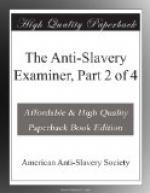Finally, this clause prohibits the taking for public use of “property.” The constitution of the United States does not recognize slaves as “PROPERTY” any where, and it does not recognize them in any sense in the District of Columbia. All allusions to them in the constitution recognize them as “persons.” Every reference to them points solely to the element of personality; and thus, by the strongest implication, declares that the constitution knows them only as “persons,” and will not recognize them in any other light. If they escape into free States, the constitution authorizes their being taken back. But how? Not as the property of an “owner,” but as “persons;” and the peculiarity of the expression is a marked recognition of their personality—a refusal to recognize them as chattels—“persons held to service.” Are oxen “held to service?” That can be affirmed only of persons. Again, slaves give political power as “persons.” The constitution, in settling the principle of representation, requires their enumeration in the census. How? As property? Then why not include race horses and game cocks? Slaves, like other inhabitants, are enumerated as “persons.” So by the constitution, the government was pledged to non-interference with “the migration or importation of such persons” as the States might think proper to admit until 1808, and authorized the laying of a tax on each “person” so admitted. Further, slaves are recognized as persons by the exaction of their allegiance to the government. For offences against the government slaves are tried as persons; as persons they are entitled to counsel for their defence, to the rules of evidence, and to “due process of law,” and as persons they are punished. True, they are loaded with cruel disabilities in courts of law, such as greatly obstruct and often inevitably defeat the ends of justice, yet they are still recognized as persons. Even in the legislation of Congress, and in the diplomacy of the general government, notwithstanding the frequent and wide departures from the integrity of the constitution on this subject, slaves are not recognized as property without qualification. Congress has always refused to grant compensation for slaves killed or taken by the enemy, even when these slaves had been impressed into the United States’ service. In half a score of cases since the last war, Congress has rejected




